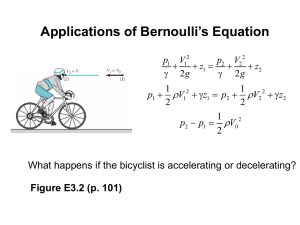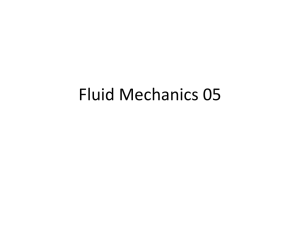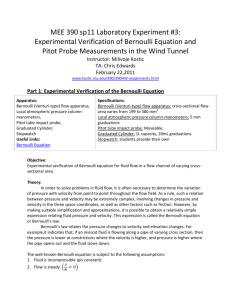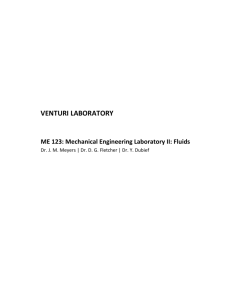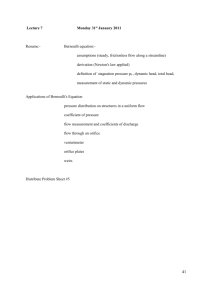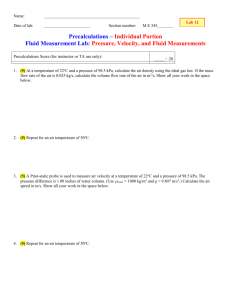CEGE1009_Sheet4_SOLN
advertisement
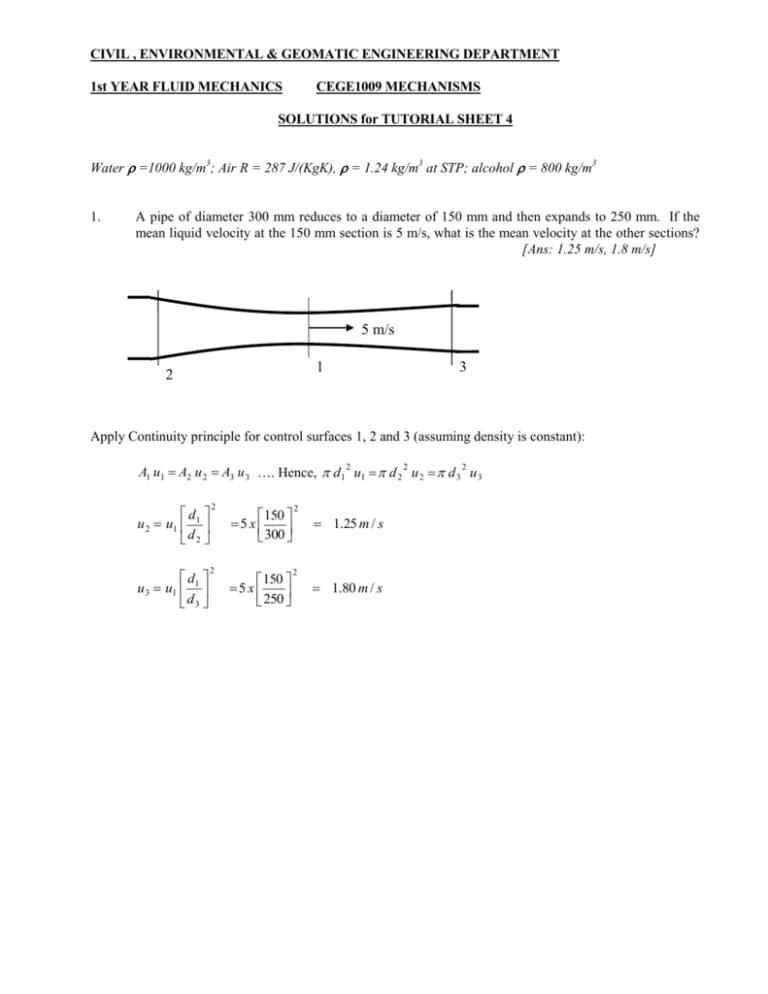
CIVIL , ENVIRONMENTAL & GEOMATIC ENGINEERING DEPARTMENT 1st YEAR FLUID MECHANICS CEGE1009 MECHANISMS SOLUTIONS for TUTORIAL SHEET 4 Water =1000 kg/m3; Air R = 287 J/(KgK), = 1.24 kg/m3 at STP; alcohol = 800 kg/m3 1. A pipe of diameter 300 mm reduces to a diameter of 150 mm and then expands to 250 mm. If the mean liquid velocity at the 150 mm section is 5 m/s, what is the mean velocity at the other sections? [Ans: 1.25 m/s, 1.8 m/s] 5 m/s 1 2 3 Apply Continuity principle for control surfaces 1, 2 and 3 (assuming density is constant): A1 u1 A2 u 2 A3 u 3 …. Hence, d1 u1 d 2 u 2 d 3 u 3 2 d u 2 u1 1 d2 2 d u 3 u1 1 d3 2 150 5 x 300 2 150 5 x 250 2 1.25 m / s 1.80 m / s 2 2 2. Two-dimensional flow takes place between two parallel solid plane boundaries a distance 2a apart. The velocity distribution in the flow is described by the equation: u = U (1 - y2/a2) so that U is the maximum velocity on the centreline and the velocity is zero at each boundary where y = ± a. Show that the mean velocity in the flow is 2U/3 1 y = +a u dy y u y U y = -a 1 2D flow, so independent of coordinate z into the paper; to keep units correct, consider unit thickness into paper: y2 u U 1 2 a Given that velocity varies spatially as: . Mass flow (flux) across control surface 1 – 1 for element dy: dm u dy ( x 1) for unit thickness . a a Hence, total flow is: m u dy a U (1 a y2 ) dy a2 . is defined by the equation: m AU Mean velocity U a Hence 2a U U (1 a y2 ) dy a2 a And y3 U U y 2 2a 3a a U 2a (a) 3 U a ( a ) ( a 2a 3 3a 2 2a 2a 3 2U 3 where A is the cross sectional area = 2 a x 1 3. The figure shows a section along a wind tunnel drawing air from a laboratory where the pressure is atmospheric. When the speed in the 0.5 m diameter working section is at the maximum of 35 m/s, calculate the gauge pressures (i) in the working section, and (ii) at section A-A where the diameter is 1.5 m. If slope reservoir manometers containing alcohol and with slope arcsin (0.1) are used to measure these pressures, calculate their readings. [Ans: - 759.5 Pa, - 9.38 Pa, 96.8 cm, 1.2 cm] q=0 p=patm q2, p2 q1, p1 By continuity, air flow at the inlet must equal that in the working section. Hence: q1 A1 q1 A2 2 A2 d 35 q 2 2 2 q 2 m/s A1 9 d1 Applying Bernoulli’s equation along the streamline (starting in a distant corner of the laboratory),using absolute pressures, and noting that the g z term is negligible for air: q1 p 2 12 q 2 p1 12 q1 p atm 0 stagnation pressure, in the test section where velocity = 0; 2 2 p 2 p atm 12 q 2 12 x 1.24 x 35 2 2 p1 p atm 12 q1 12 x 1.24 x 2 and kg m 2 759.5 Pa m3 s 2 2 35 kg m 2 9.4 Pa 9 m3 s 2 Both pressures are below atmospheric, so the manometer is connected as shown below: L patm p1 θ C C’ To obtain readings on a sloping manometer, equate pressures on its two sides at level C – C’: p atm p1 Pa m 3 k g 9.4 0.012 m alc g sin 800 x 9.81 x 0.1 k g N p atm p1 alc g L1 sin ; L1 p atm p 2 alc g L2 sin ; L2 p atm p 2 Pa m 3 kg 759 .5 0.968 m alc g sin 800 x 9.81 x 0.1 kg N 4. A model of a cooling tower of circular cross-section is to be tested in the tunnel in Q.3 at the maximum speed. What is the gauge pressure at the stagnation point on the model? If the minimum value of pressure coefficient recorded on the upstream side of the model is - 1.1, what is the maximum velocity on the model? [Ans: ???, 50.72 m/s] q, p HORIZONTAL SECTION q∞ , p∞ “Free stream” conditions in the working section of the wind tunnel are denoted by the suffix: ∞ , hence p∞ , q∞ i.e. picking up notation from the last example: p∞ ≡ p2 , q∞ ≡ q2 = 35 m/s Now, applying Bernoulli’s equation along the streamline shown: 2 p 12 q p 12 q 2 p0 patm Hence, at the Stagnation Point, where q = 0, p s p 0 p atm and gauge pressure is zero. On the model cooling tower, the minimum pressure coefficient = -1.1 But C p p p 1 2 q 2 q 1 q 2 , so when pressure is minimum, velocity is maximum; q Hence, for Cp = -1.1, (at minimum), 1.1 1 max imum q And q max imum 2.1 q 2.1 x 35 50.7 m / s 2 5. State the assumptions involved in deriving Bernoulli's equation. A free jet of air of circular cross-section and diameter 60 cm is formed for test purposes in a laboratory where the ambient pressure is atmospheric. A Pitot-static tube is arranged in the jet and is attached to a vertical U-tube manometer containing alcohol. If the difference in levels recorded by the manometer is 65 mm, find the air speed. The Pitot static tube is removed and replaced by a small body which is equipped with static pressure holes in its surface. If the minimum gauge pressure recorded on the body is found to be - 310 Pa, find the maximum velocity on the body. State the values of pressure coefficient on the body (i) at the stagnation point, and (ii) at a point where the velocity achieves a value 50% above the value in the jet. [Ans: 28.7m/s, 36.4 m/s,?, - 1.25 ] p∞ p0 u∞ ρair Air jet p∞ patm Manometer h C C’ Bernoulli’s equation is derived for steady, incompressible flow along a streamline with no shear forces acting (no friction, inviscid); thus the only forces acting are caused by pressure and gravity. Flow in a free jet of air is different from flow in a wind tunnel - the pressure in the jet must be atmospheric for equilibrium of the elements of air at the edge of the jet. In the case of a wind tunnel, the tunnel walls sustain the suction pressures inside the tunnel. Consider Bernoulli along the streamline impinging on the tip of the Pitot-static tube: p 12 q p 0 2 ….. hence, q 2 p 0 p atm We find the ( p 0 p atm ) from the manometer reading h. Equating pressures at level C-C’: p 0 p alcohol g h ; hence p0 p air 2 alcohol g h alcohol g h 2 x 800 x 9.81 x 0.065 and q = 28.7 m/s air 1.24 air Now considering the small model object placed in the air jet. Applying Bernoulli along the streamline leading to the point of minimum gauge pressure (-310 Pa): p 0 p 12 q 2 p 12 q i.e. q max 2 2 p p min q 2 ... hence minimum pressure corresponds to maximum velocity. 2 Given that minimum gauge pressure p p atm 310 Pa And knowing that p p atm for a free air jet, we see that p p 310 Pa Hence: q max 2 2 2 x 310 N m 3 2 m 28 . 7 1.24 m 2 k g s2 500 822 .8 1323 And q max 36.4 m / s Now, C p p p 1 2 q 2 q 1 q 2 Hence, at Stagnation Point where q = 0, Cp = 1 1.5 q And at the point where q 1.5 x q , C p 1 q 2 1.25 m2 s2

